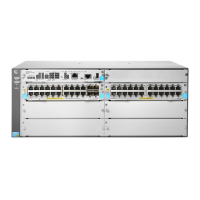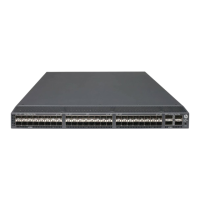55
Step Command Remarks
interface view or Layer 2
aggregate interface view.
interface-number
3. Configure the link type of the
interface as trunk.
port link-type trunk
By default, the link type of an interface is
access.
For more information about the command,
see Layer 2—LAN Switching Command
Reference.
4. Assign the trunk port to the
protected VLANs of the
RRPP domain.
port trunk permit vlan
{ vlan-id-list |
all
}
By default, a trunk port allows only packets
from VLAN 1 to pass through.
RRPP ports always allow packets from the
control VLANs to pass through.
For more information about the command,
see Layer 2—LAN Switching Command
Reference.
5. Disable the spanning tree
feature.
undo stp enable
By default, the spanning tree feature is
enabled.
For more information about the command,
see Layer 2—LAN Switching Command
Reference.
Configuring RRPP nodes
The maximum number of rings that can be configured on a device in all RRPP domains is 128.
If a device carries multiple RRPP rings in an RRPP domain, it can only be an edge node or an
assistant edge node on a subring.
Specifying a master node
Step Command Remarks
1. Enter system view.
system-view
N/A
2. Enter RRPP domain
view.
rrpp domain
domain-id N/A
3. Specify the current
device as the master
node of the ring, and
specify the primary port
and the secondary port.
ring
ring-id
node-mode
master
[
primary-port
interface-type
interface-number ] [
secondary-port
interface-type interface-number
]
level
level-value
By default, the device is not a
node of the RRPP ring.
Specifying a transit node
Step Command Remarks
1. Enter system view.
system-view
N/A
2. Enter RRPP domain
view.
rrpp domain
domain-id N/A
3. Specify the current
device as a transit node
of the ring, and specify
the primary port and the
secondary port.
ring
ring-id
node-mode
transit
[
primary-port
interface-type
interface-number ] [
secondary-port
interface-type interface-number ]
level
level-value
By default, the device is not a
node of the RRPP ring.

